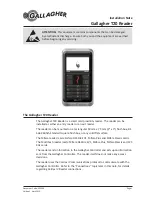
xr
PRELIMINARY
XRT86VL38
REV. P1.0.6
OCTAL T1/E1/J1 FRAMER/LIU COMBO
374
10.2.3
Multiplexed High-Speed Mode
When the Back-plane interface data rate is 12.352Mbit/s, 16.384Mbit/s, HMVIP 16.384Mbit/s, and H.100
16.384Mbit/s, the interface signals are all configured as inputs, except the receive serial data on RxSER and
the multi frame sync pulse provided by the framer. The Back-plane Interface is processing data through
TxSER0 or TxSER4 pins at 12.352Mbit/s or 16.384Mbit/s. The local Terminal Equipment multiplexes payload
and signaling data of every four channels into one serial data stream. Payload and signaling data of Channel 0-
3 are multiplexed onto the Transmit Serial Data pin of Channel 0. Payload and signaling data of Channel 4-7
are multiplexed onto the Transmit Serial Data pin of Channel 4. Free-running clocks of 12.352MHz are
supplied to the Transmit Input Clock pin of Channel 0 and Channel 4 of the framer. The local Terminal
Equipment provides multiplexed payload data at rising edge of this Transmit Input Clock. The Transmit High-
speed Back-plane Interface of the framer then latches incoming serial data at falling edge of the clock.
Transmit 12.352 Bit-Multiplexed Mode
The local Terminal Equipment maps four 1.544Mbit/s DS1 data streams into one 12.352Mbit/s serial data
stream as described below:
1.
The F-bit of four channels are repeated and grouped together to form the first octet of the multiplexed data
stream. The F-bit of Channel 0 is sent first, followed by F-bit of Channel 1 and 2. The F-bit of Channel 3 is
sent last. The table below shows bit-pattern of the first octet.
F
X
: F-bit of Channel X
2.
Payload data of four channels are repeated and grouped together in a bit-interleaved way. The first pay-
load bit of Timeslot 0 of Channel 0 is sent first, followed by the first payload bit of Timeslot 0 of Channel 1
and 2. The first payload bit of Timeslot 0 of Channel 3 is sent last. After the first bits of Timeslot 0 of all four
channels are sent, it comes the second bit of Timeslot 0 of Channel 0 and so on. The table below demon-
strates how payload bits of four channels are mapped into the 12.352Mbit/s data stream.
F
IGURE
90. W
AVEFORMS
FOR
C
ONNECTING
THE
R
ECEIVE
N
ON
-M
ULTIPLEXED
H
IGH
-S
PEED
I
NPUT
I
NTERFACE
AT
MVIP 2.048M
BIT
/
S
, 4.096M
BIT
/
S
,
AND
8.192M
BIT
/
S
B
IT
0
B
IT
1
B
IT
2
B
IT
3
B
IT
4
B
IT
5
B
IT
6
B
IT
7
F
0
F
0
F
1
F
1
F
2
F
2
F
3
F
3
B
IT
0
B
IT
1
B
IT
2
B
IT
3
B
IT
4
B
IT
5
B
IT
6
B
IT
7
1
0
1
0
1
1
1
1
1
2
1
2
1
3
1
3
RxSER
RxSYNC(input)
RxCHCLK(INV)
RxCHN[0]/RxSig
RxCHN[1]/RxFrTD
F
8
7
6
5
4
3
2
1
8
7
6
5
4
3
2
1
8
7
6
5
4
3
2
1
8
7
6
5
4
3
2
1
C
A B
D
Don't Care
C
A B
D
Don't Care
C
A B
D
Don't Care
C
A B
D
Don't Care
Note: The following signals are not aligned with the signals shown above. The RxTSClk is derived from 1.544MHz transmit clock.
Don't Care
8
7
6
5
4
3
2
1
Don't Care
8
7
6
5
4
3
2
1
Don't Care
Don't care
Don't care
RxSERCLK
(2/4/8MHz)
















































